What’s Up?
As far as sleeping through the great Northern Lights Display, I was not, for several reasons), bothered much at all by missing it. Based on the information that I had, I made the decision to get some needed rest. So I did. In addition, I had seen them on a bone-chilling night in Denali about 20 years ago. They were spectacular, but I had no idea about how to photograph them. My only regret was not being able to loan my new Sony 12-24mm f/2.8 lens to roommate Bob Eastman because I had left it on the boat.
The “guaranteed” 8-16-inch snowfall never materialized. It snowed overnight from Monday into Tuesday, so we had three inches of fresh snow on the ground> We did not, however, get to shoot the eagles in flight in falling snow. We did have a very nice east wind, so we made many excellent landing eagle images on Tuesday morning and stayed out for five hours. The snow acts as a giant reflector that lights up the undersides of the eagle’s wings. It snowed overnight again from Tuesday into Wednesday, so we will have more fresh snow on the ground today.
Speaking of which, today is Wednesday 1 March 2023. It looks as if we will get in another long morning sessions unless the wind picks up early. They have been predicting high winds and ten-foot seas for days now but keep pushing it back. This blog post took about 2 hours to prepare (including the time spent on the image optimizations) and makes three hundred thirty-six days in a row with a new educational post written just for you. Wherever you are and whatever you are doing, I hope that you too have a great day.
Please, please, pretty please remember to use my B&H or Bedford’s affiliate programs for all your new gear purchases. If you use B&H, please be sure to click on any B&H link in the blog to start your search. Or simply start with this link. There is always the option of e-mailing me for gear advice and for the correct links.
The plan is to continue to post every day until the streak reaches one year and one day and then begin posting every other day.
Please remember to use the B&H and Amazon links that are found on most blog pages and to use the BIRDSASART discount code at checkout when purchasing your new gear from Bedfords to get 3% back on your credit card and enjoy free second-day air FedEx. Please, also, consider joining a BAA IPT. You will be amazed at how much you will learn!
You can find some great photo accessories (and necessities, like surf booties!) on Amazon by clicking on the Stuff tab on the orange/yellow menu bar above. On a related note, it would be extremely helpful if blog-folks who, like me, spend too much money on Amazon, would get in the habit of clicking on the Amazon logo link on the right side of each blog post when they shop online. As you might expect, doing so will not cost you a single penny, but would be appreciated tremendously by yours truly. And doing so, works seamlessly with your Amazon Prime account.
Please remember that if an item — a Delkin flash card, or a tripod head — for example, that is available from B&H and/or Bedfords, is also available in the BAA Online Store, it would be great, and greatly appreciated, if you would opt to purchase from us. We will match any price. Please remember also to use my B&H affiliate links or to earn 3% cash back at Bedfords by using the BIRDSASART discount code at checkout for your major gear purchases. Doing either often earns you free guides and/or discounts. And always earns my great appreciation.
|
|
|
This image was created on 27 February 2023 on the second Bald Eagle Instructional Photo-Tour at Kachemak Bay, Homer, AK. I used the hand held Sony FE 70-200mm f/2.8 GM OSS II lens with the Sony FE 1.4x Teleconverter (at 112mm) and The One, the Sony Alpha 1 Mirrorless Digital Camera.. The exposure was determined via Zebras. ISO 640: 1/5000 sec. at f/4 (wide open) in Manual mode. AWB at 9:37:45am on a mostly sunny morning. Tracking: Zone AF/C with Bird-Eye/Face Detection performed perfectly. Click on the image to enjoy a high-res version. Image #1: Glaucous-winged Gull turning in flightYour browser does not support iFrame. |
Larus glaucescens
The genus name for Glaucous-winged Gull, Larus, is from the ancient Greek laros (λάῥος) or the Latin, larus, that refers to a gull or (other large seabird). The specific epithet, glaucescens, is New Latin for “glaucous” from the Ancient Greek, glaukos, denoting the light grey color of the birds’ wings.
You will notice in all five images that the species has light grey primary tips. In many gull species, those feathers are black, and in others, like Iceland Gull (similarly named Larus glaucoides), they are white. Glaucous-winged is a large gull with bright pink feet and a red pecking spot on the distal end of the lower mandible. They are the most common Gull in Homer in winter and in much of the Pacific Northwest.
|
|
|
This image was created also on 27 February 2023 on the second Bald Eagle Instructional Photo-Tour at Kachemak Bay, Homer, AK. Again, I used the hand held Sony FE 70-200mm f/2.8 GM OSS II lens with the Sony FE 1.4x Teleconverter (this one at 280mm) and The One, the Sony Alpha 1 Mirrorless Digital Camera.. The exposure was determined via Zebras. ISO 500: 1/6400 sec. at f/4 (wide open) in Manual mode. AWB at 10:01:26am on a mostly sunny morning. Tracking: Expand Spot AF/C with Bird-Eye/Face Detection performed perfectly. Click on the image to enjoy a high-res version. Image #2: Glaucous-winged Gull taking flightYour browser does not support iFrame. |
Attracting Gulls Instead of Eagles
I’ve loved photographing gulls for many decades. Way back when, I did an article for the now-defunct Birder’s World Magazine entitled Go For the Gulls. Why? Gulls are common in many parts of the country, are often used to people, and if you point a lens at them, they will often do something interesting. In addition, as most gulls have lots of white in their plumage, they are ideal subjects for those who are working on honing their exposure skills. As the whites on Glaucous-winged Gull are much brighter than the whites on the head of an adult Bald Eagle, I advise the group to shoot two clicks higher when photographing the gulls. Thus, the extremely high shutter speeds.
On Monday, after creating thousands of Bald Eagle flight images on a sunny morning in near-perfect conditions, I asked Captain Gabe if he could figure out a way to attract gulls without attiring the eagles. (With dozens of eagles around the boat, the gulls are driven off). In short order, he came up with a solution to what seemed like an impossible request.
|
|
|
This image was created also on 27 February 2023 on the second Bald Eagle Instructional Photo-Tour at Kachemak Bay, Homer, AK. Again, I used the hand held Sony FE 70-200mm f/2.8 GM OSS II lens with the Sony FE 1.4x Teleconverter (this one also at 280mm) and The One, the Sony Alpha 1 Mirrorless Digital Camera.. The exposure was determined via Zebras. ISO 500: 1/6400 sec. at f/4 (wide open) in Manual mode. AWB at 10:03:50am on a mostly sunny morning. Tracking: Expand Spot AF/C with Bird-Eye/Face Detection performed perfectly. Click on the image to enjoy a high-res version. Image #3: Glaucous-winged Gull vertical flight undersides imageYour browser does not support iFrame. |
Verticals from Horizontal Originals
If the birds are banking consistently, it is possible to turn your camera on end and create vertical originals. A battery grip helps with that. But if the birds are not banking consistently, the best way to go is to zoom out to avoid clipping the wings and then crop to a vertical. The banking gull in Image #3 was far enough away that I did not have to zoom out to fit it in the frame. Then, I cropped to a 3X2 vertical, easy to do with 51-millions pixels.
|
|
|
This image was created also on 27 February 2023 on the second Bald Eagle Instructional Photo-Tour at Kachemak Bay, Homer, AK. Again, I used the hand held Sony FE 70-200mm f/2.8 GM OSS II lens with the Sony FE 1.4x Teleconverter (this one at 239mm) and The One, the Sony Alpha 1 Mirrorless Digital Camera.. The exposure was determined via Zebras. ISO 400: 1/6400 sec. at f/4 (wide open) in Manual mode. AWB at 10:21:31am on a mostly sunny morning. Tracking: Expand Spot AF/C with Bird-Eye/Face Detection performed perfectly. Click on the image to enjoy a high-res version. Image #4: Glaucous-winged Gull starting diveYour browser does not support iFrame. |
Working on Dark Shadows
When photographing flight on sunny days, you will often make images with ugly dark shadows, even when working right on or close to sun angle. That was the case with Image #4. I selected the nearly black shadow on the lower breast using the Quick Selection Tool, feathered it one pixel, and put it on its own layer. Then I pulled up the curve and added a Regular Layer Mask. I painted away the still-too-obvious demarcation line with a 50% opacity brush. It was still not quite perfect, so I did some Patch Tool and Clone Stamp work and wound up happy with the result. All as detailed in The BIRDS AS ART Current Workflow e-Guide (Digital Basics II). Click here and scroll down for purchasing options.
|
|
|
This image was created also on 27 February 2023 on the second Bald Eagle Instructional Photo-Tour at Kachemak Bay, Homer, AK. I used the hand held Sony FE 70-200mm f/2.8 GM OSS II lens (at 200mm) and The One, the Sony Alpha 1 Mirrorless Digital Camera.. The exposure was determined via Zebras. ISO 400: 1/3200 sec. at f/2.8 (wide open) in Manual mode. AWB at 9:15:031am on a very cloudy morning. Tracking: Expand Spot AF/C with Bird-Eye/Face Detection performed perfectly. Click on the image to enjoy a high-res version. Image #5: Glaucous-winged Gull calling in flightYour browser does not support iFrame. |
Working a Subject
Note that I made hundreds of images of Glaucous-winged both in flight and on the water. I strived to create images depicting various flight poses and behaviors and still have many more good ones. Too many folks make one image of a bird, think, “I got it,” and move on to something else. Which group are you in?
Your Call
Click on each horizontal image to enlarge it and leave a comment denoting your favorite image and why you like it. And then do the same letting us know which is your least favorite image and why you did not like it. I will share my thoughts here tomorrow.
Typos
With all blog posts, feel free to e-mail or to leave a comment regarding any typos or errors.

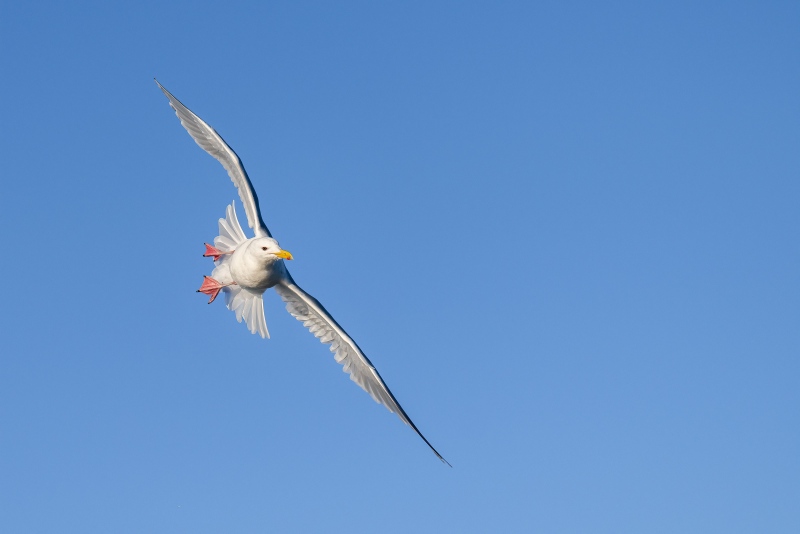
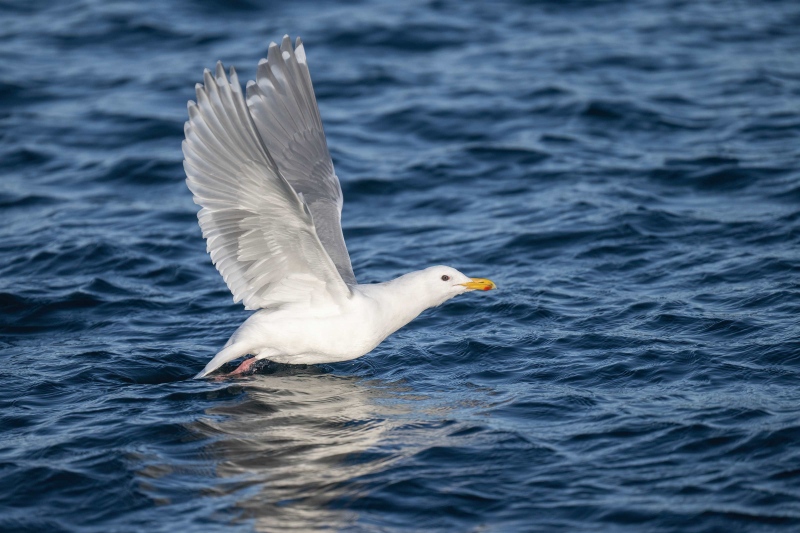
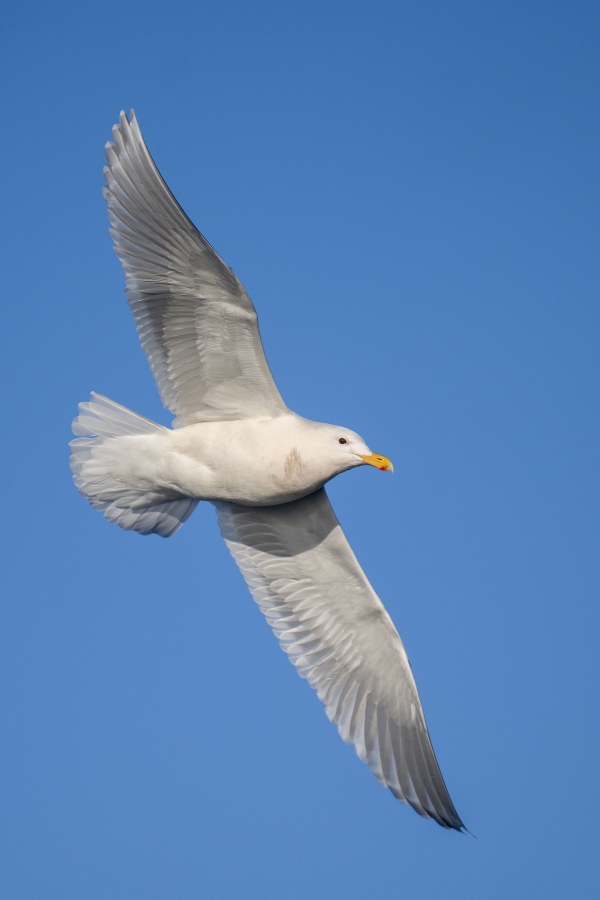
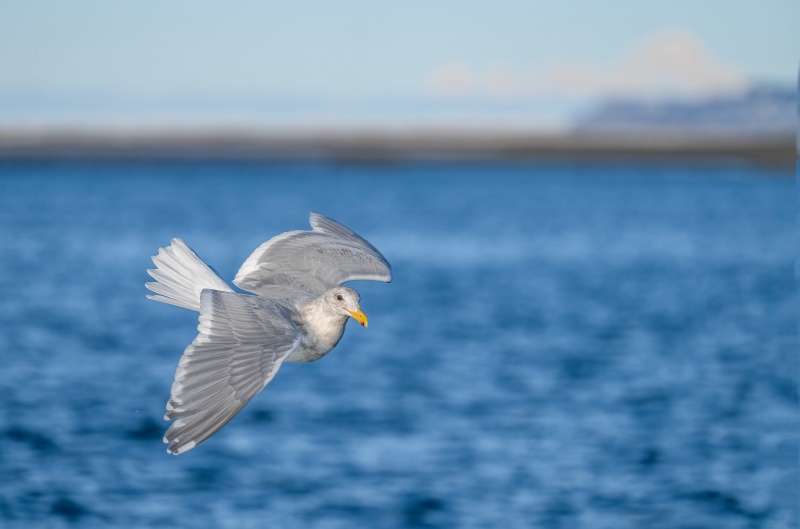
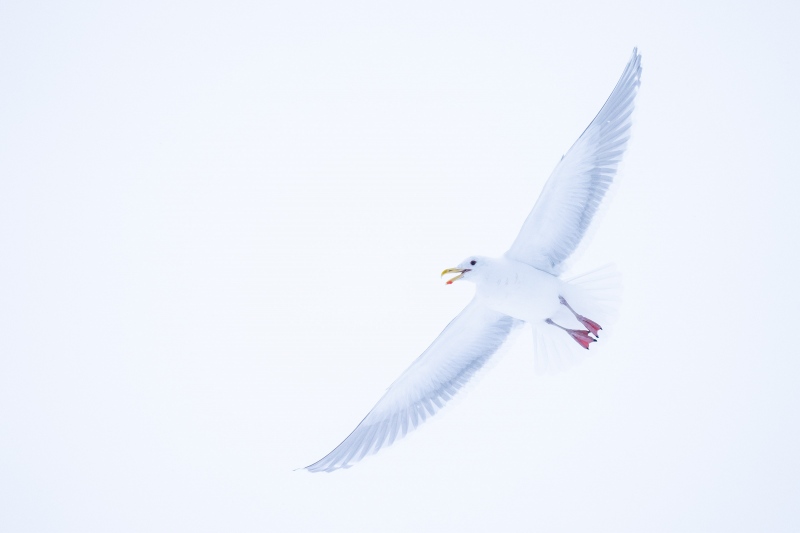













Glaucous-winged Gull in images #1 and #2 and #3 and #4 are cute and good! Image #5 is a little bit dark with Glaucous-winged Gull showing.
Thanks for commenting Sue. With all due respect, if Image #5 looks dark you need to get a new monitor.
with love, artie